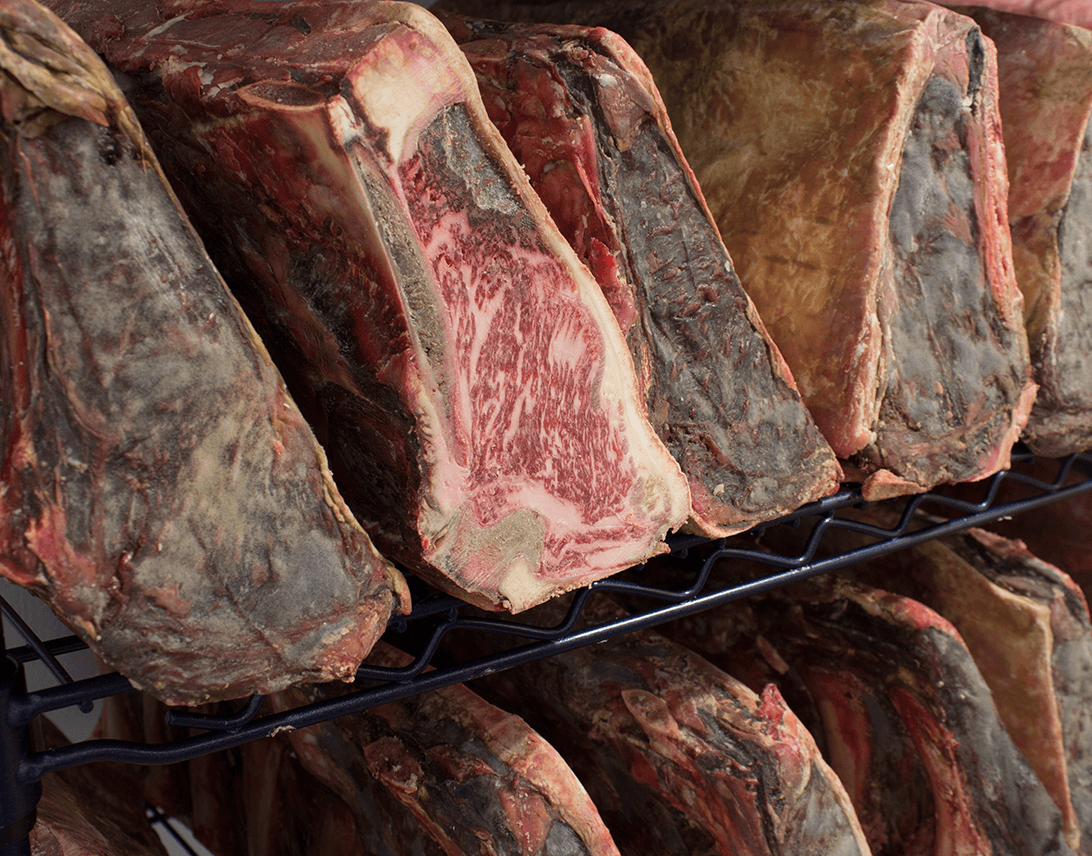

What is Aged Beef?
The ‘age’ of meat is simply the amount of time that has elapsed from slaughter to consumption. Unless you’re slaughtering your own meat, pretty much all beef purchased nowadays will have some amount of age on it.
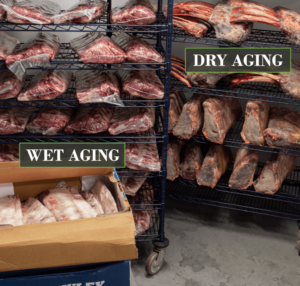
Wet vs Dry Aging
Wet Aged vs Dry Aged Beef
There are two types of aging – Wet Aging and Dry Aging. The main difference between the two types of aging is the presence, or lack, of oxygen. Wet Aging is done by leaving large muscle groups, called subprimals, within vacuum sealed packaging for a period of time under temperature control. Put even more simply – vacuum sealed meat, in a refrigerator – Bam, you’re wet aging. When you introduce oxygen to the meat (by removing it from the sealed packaging), you are Dry Aging.
Is Wet Aging or Dry Aging Better?
Both Wet Aging and Dry Aging will increase the tenderness of the meat. Post mortem, enzymes within the meat – proteolytic enzymes such as calpains, cathepsins, and caspases, if you want to get geeky – will begin to break down the muscle fibers. The structural changes to the proteins are the main cause of tenderization during aging, and this process will happen regardless of if the subprimal is vacuum sealed, or exposed to air.
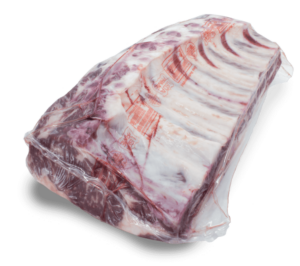
Wet Aged Bone-in Rib
When it comes to flavor enhancement, Dry Aging has the upper hand. By exposing the subprimal to oxygen, you allow two very important actions to take place. Moisture evaporates from within the muscle, and in the right environments, certain microbial elements develop. Let’s be real; that’s just a fancy way to say “mold,” which plays a key role in the flavor of finished steaks.
How Dry Aging Impacts Flavor
A good analogy for any of you who enjoy cooking is to think of what happens when you turn a stock into a demi. As the moisture evaporates, the flavor concentrates. For those of you who don’t regularly enjoy making messes in your kitchen, stock is like a broth. By simmering bones in water, you will impart that flavor into the water. Stocks are widely used as the basis for soup. A demi, or demi-glace, is a much thicker liquid that is made by simmering a pot of stock on a low flame until enough water evaporates to reach the desired consistency.
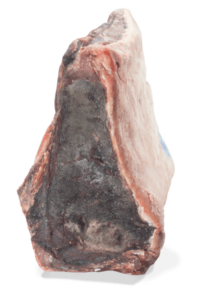
Dry Aged Bone-in Striploin
All that is happening during that simmering process is the heat causing the water molecules in the stock to slowly evaporate. But the flavor of the stock isn’t leaving the stovetop with those water molecules; it remains in the pot. At the end of the process, you have one-fifth the amount of liquid, but with the same amount of flavor. A spoonful of demi will pack the same flavor punch as several cups of stock.
The concept is the same for dry aged beef. Instead of putting that pot of stock over a low flame and waiting 24 hours, beef primals are exposed to the open air in a controlled aging environment and left for anywhere from seven to 60 days (or longer, depending how crazy you are). By ensuring the primals are open to the air on all sides, it allows the moisture within the meat to slowly evaporate over time.
The other facet of flavor development is microbial growth. To use another food analogy; let’s talk about the similarities between Dry Aging beef and Cheesemaking. In both processes, the use of molds plays a significant role in developing distinct flavors. In dry aging beef, certain species of molds can form on the meat’s surface during the aging process. These molds contribute to the breakdown of proteins and fats, resulting in enhanced tenderness and the development of complex, earthy flavors.
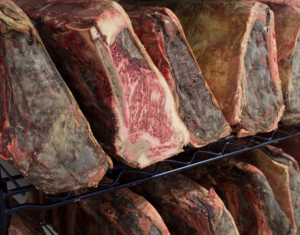
The exterior of the meat takes the brunt of the dry aging process – when enough time has passed, the exterior is trimmed, revealing the perfectly aging steak within
Similarly, in cheesemaking, specific molds are employed to create unique flavors and textures. For instance, blue cheeses like Roquefort or Gorgonzola are intentionally inoculated with Penicillium roqueforti or Penicillium glaucum. These molds introduce characteristic blue veins throughout the cheese, imparting a tangy and slightly piquant taste.
Both processes require careful monitoring and control to achieve desired outcomes, ensuring the molds contribute positively to the overall sensory experience of the final product. The presence, or absence, of certain species of mold plays a large role in why you will experience such drastic flavor profiles if sampling dry aged steaks from different suppliers.
Stay tuned for more. In the meantime, shop from our selection of expertly dry aged steaks.
